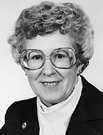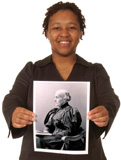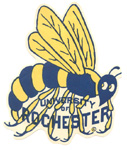![[NEWS AND FACTS BANNER]](/URClipArt/news/titleNewsFactswide.jpg) |
||||||||||||||||||

|
||||||||||||||||||
Features
Innovation at Rochester:
|
||||||||||||||||||
T – Z |
T
Tunnel Painting
 |
Who was the first tunnel painter? Sadly, the history books don’t record who should be credited with the idea of using the often-traveled Rochester tunnels as an outlet for student wit.
 |
The aphorisms, exhortations, and slogans—along with, in many cases, elaborate artwork—began showing up on the walls of the cross tunnel in the early 1970s. And while the messages have changed over the past 30 years, the medium remains the same.
U
Unification Model of Nursing
 |
Ford |
Nurses have not been seen as “doctors’ handmaidens” in more than a quarter century, due in large part to the field-shifting ideas pioneered by Rochester’s Unification Model of Nursing.
First proposed by Loretta Ford, founding dean of the School of Nursing, the model developed into a curriculum that drew on both research and clinical strengths of the profession. The results were new career options for nurses as well as new standing as important professional contributors to the health of patients.
V
Graduate Program in
Visual and Cultural Studies
 |
So much of the understanding of art and art history takes place outside the framework that tries to define individual works into categories such as “masterpiece.”
That’s one of the premises behind Rochester’s Graduate Program in Visual and Cultural Studies, the first such program offered at a university in the United States.
Drawing on the social, cultural, and historical perspectives of a wide range of humanities disciplines, students and scholars in the program analyze visual arts in a comprehensive and contextual way. Since its founding, the program has been copied at universities across the country.
W
Wind Ensemble
 |
“He really began the whole wind ensemble movement,” longtime ensemble director and Eastman professor Donald Hunsberger noted at the ensemble’s 50th anniversary celebration in 2002.
Smaller than a full orchestra, yet more sophisticated in repertoire than traditional “big” bands, the wind ensemble proved to be just the right size for many schools and universities, and the ensembles have become mainstays of musical education.
X
X Chromosomes: Coeducation
 |
Fitzpatrick |
Stephanie Fitzpatrick ’04 remembers being inspired by the words of Susan B. Anthony and fellow suffragist Elizabeth Cady Stanton when she was in high school in Kentucky. Fitzpatrick and classmates read selections of the famous suffragists’ correspondence as part of her work to organize conferences on leadership for girls.
Last spring, Fitzpatrick (above), a psychology major who plans to pursue a Ph.D. in health psychology, was named the 2003 Susan B. Anthony Scholarship Award winner, selected by the University’s Anthony Center for Women’s Leaderhip.
Her advice to future generations of women: “Even if your goals don’t look as if they are an option, pursue them anyway. You may end up on a slightly different path or you may stay on your original path, but you will get much more out of life by trying to reach them.”
Thanks to Anthony’s tireless efforts, Rochester became a coeducational institution in 1900. Today, women comprise close to half of each undergraduate class.
Y
Yellow: Dandelion and Yellowjacket
 |
Who else has such a pairing of mascots?
Z
Zen and the Science of Mindful Maintenance
 |
Being attuned to and aware of the present—a state of consciousness known as “mindfulness”—may be beneficial to your mental health, according to research by Rochester experts on the psychology of motivation.
Their Mindful Attention Awareness Scale, published this year, is the latest in a long history of insight by Rochester psychologists who study ways to enhance positive psychological health.
Not surprisingly, practitioners of Zen, who actively cultivate a heightened awareness of what’s taking place in the present moment, scored higher on the scale than a similar sample of nonpractitioners.
“Mindfulness appears to heighten the joys one can experience in everyday events, as well as to be in better touch with what one really needs and feels,” says Richard Ryan, professor of psychology and psychiatry and coauthor of the new scale. “It helps people make better choices in a complex world.”
| SEARCH: Directory | Index | Contact | Calendar | News | Giving | |||